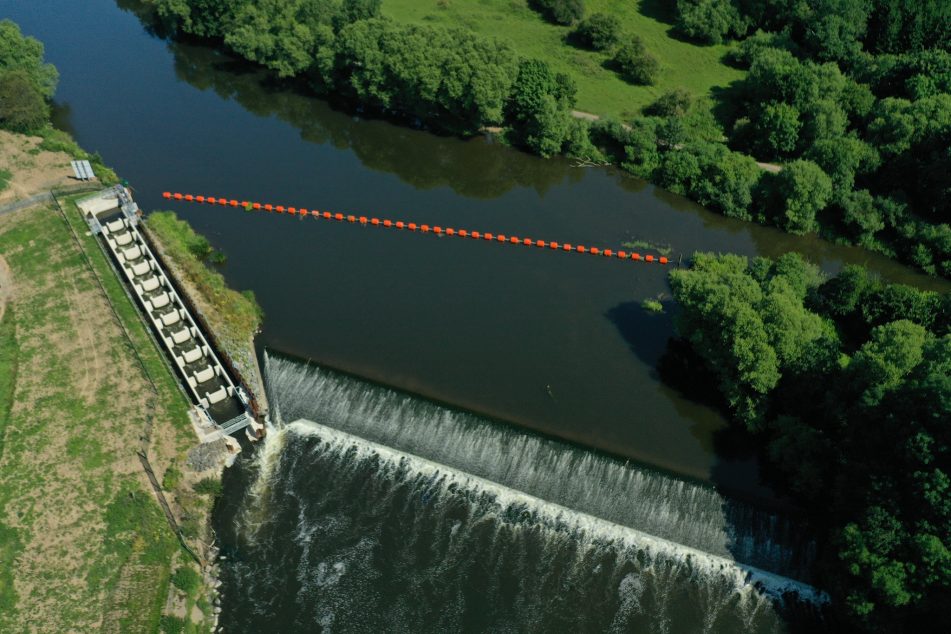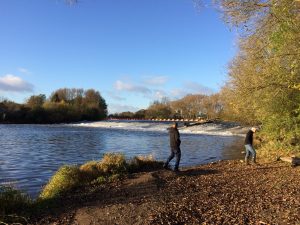
What is a fish pass?
We hear this question a lot when people first learn about our project.
In its simplest terms, a fish pass is a structure built into or alongside the river, designed to give fish a way to move around a human barrier such as a weir or a dam.
What is a fish ladder?
A fish ladder is just another term for a fish pass. The term ‘fish ladder’ is more commonly used in North America.
Why do fish need fish passes?
Fish are wild creatures. They need to move about on the river. In fact, the amount that different kinds of fish journey up and down the river can be surprising. Even species that we don’t typically think of as ‘migratory’ will need to move around the river.
For example, researchers from Bournemouth University working in association with Unlocking the Severn tagged a barbel on the River Severn that travelled 206 km over the 13 months that they were able to track it. A tagged River Severn pike recorded a total distance of nearly 500 km travel over the 19 months that its movements were detected. These fish were fitted with tiny acoustic tags that each send a unique acoustic ‘ping’ to recording devices in the river when the fish pass by. The research took place before our fish passes began unlocking the River Severn for fish. But the widest ranging barbel travelled up and down a 52km long area of the river. And 4 of the 15 pike for which movement data was recorded had home ranges along the river that exceeded 23km in length. (Roberts, Nolan, Davies, Bolland and Britton, 2020)1.
Fish must migrate up and down rivers for feeding, to avoid predators; and to seek shelter from extreme flow levels or extreme river temperatures. Extreme flow and temperatures may arise when a river goes into flood, or if it the water gets too shallow and warm in a summer drought. Finally, and crucial for the success of future generations, fish also need to travel along the river to find mates and suitable habitat for spawning in.
What is a fish pass for?
So, feeding, safety, shelter, and spawning are the four important reasons that fish need to move up and down the river. Human barriers on the river prevents fish moving freely: either because they physically can’t pass the obstacle, or it is because it is difficult and therefore costly of their time and energy to pass over it. Installing a fish pass can provide a way around.
Rivers connect freshwater and marine ecosystems.
In their natural state, free flowing rivers connect a diverse range of habitats along the length of the river from source to sea. Rivers transport fresh water and sediment down through the river system, and then finally out to sea. But rivers are also the conduit for important, hidden migration journeys that take place in the opposite direction, back up river from the sea. Certain types of fish live, feed and grow out at sea but come back into freshwater to spawn. These spawning migrations can involve epic river journeys. Fish with this kind of lifecycle are called anadromous. Anadromous species include the iconic salmon, as well as lamprey and twaite shad.
The importance of fish passes for migratory fish
Anadromous migratory fish are particularly impacted by humanmade barriers in rivers, as they need to make long journeys to reach spawning grounds up-river. The effects of barriers are exacerbated where fish encounter a series of obstacles on their journey. Research part-funded by our project, has shown how multiple weirs on the River Severn create a cumulative effect on endangered sea lamprey. The successive barriers significantly delay individuals on their upstream spawning migration and limit their final spawning habitat (Davies, Britton, Nunn, Dodd, Bainger, Velterop, Bolland, 2021)2.
European eels are another endangered migratory fish that travel from ocean onto the River Severn to find important habitat. But eels are catadromous – they live most of their lives in the river but are born in the ocean. And they eventually migrate back out to the ocean to spawn the next generation. Eels begin their life out in the Sargasso Sea in the Caribbean. The larvae then drift 1000’s of miles on ocean currents to river systems in western Europe where they travel upriver to feed and grow in freshwater. Eels can live in freshwater for as long as 5-20 years before returning out to sea as mature fish. So, unlike salmon and shad, eels are not migrating up river to spawn, but rather to mature. It is still just as critical that eels can find a way around humanmade barriers on the river.
You can find out more about the Eel of the River Severn in this Razor TV documentary programme.
Barriers affect river habitats.
As well as impeding the movement of fish, artificial barriers also affect the natural movement of other organisms such as river insects in their nymph and larval stages, and aquatic plants. Barriers also interrupt and distort the natural flow of the water. This affects a river’s natural processes of transporting and sorting the sediment (pebbles, sand and silt). So, an artificial barrier in the river affects the shape and composition of the river bed, and which plants and animals can live there. Taking all these factors together, and onward cascade effects throughout the river ecosystem’s food-web, we can see that artificial barriers have a significant impact on the quality and diversity of habitats for wildlife both up and down river.
Fragmented populations are less resilient.
In a free-flowing river, all the fish of the same species can be part of a river-wide network. Individuals from different areas can migrate and populations all along the river are connected by interbreeding. These breeding exchanges allow gene flow; genetic variations that help a fish survive better or to have more offspring can, over successive generations, spread throughout the entire species residing across the whole of the river. In contrast, human barriers on the river fragment populations, and reduce the opportunity to exchange genes between them. Fragmented fish populations have less genetic diversity i.e. a smaller ‘gene pool’ to draw upon as needed, and are therefore more at risk from any external changes they experience. For example, fragmented populations may not be able to adapt quickly enough to new diseases, or to climate change.
Our next blog post in the ‘Understanding Fish Passes’ series will discuss the scale of the problem of human barriers, how salmon leaping at barriers is not a great thing, and barrier removal versus fish pass installation.
Further reading:
If you’re interested to learn more about the River Severn fish mentioned above check out our Fish of the River Severn pages – including barbel, pike, lamprey and eel.
You can also explore animation of the tagged fish moving around on the River Severn here:
See how fish move on the river
You may also be interested in these blog posts:
And you can also watch our webinar all about Fish of the River Severn!
References:
1. Gutmann Roberts, Nolan, Peter Davies, Jonathan D. Bolland and Robert Britton. (2020) “Fish movements in the River Severn basin, a multi species approach in an era of restoration.” A report to Severn Rivers Trust, October 2020 See: Unlocking the secrets of how fish move within the UK’s longest river – Unlocking the SevernUnlocking the Severn
2. Davies, Britton, Nunn, Dodd, Bainger, Velterop, Bolland. (2021). “Aquatic Conservation, Cumulative impacts of habitat fragmentation and the environmental factors affecting upstream migration in the threatened sea lamprey, Petromyzon marinus. Aquatic Conservation, 31 (9), September 2021 https://doi.org/10.1002/aqc.3625


